Mee Siam Kuah is a very traditional noodle dish in Singapore that is just as popular for lunch as it it is for breakfast!
Estimated reading time: 9 minutes
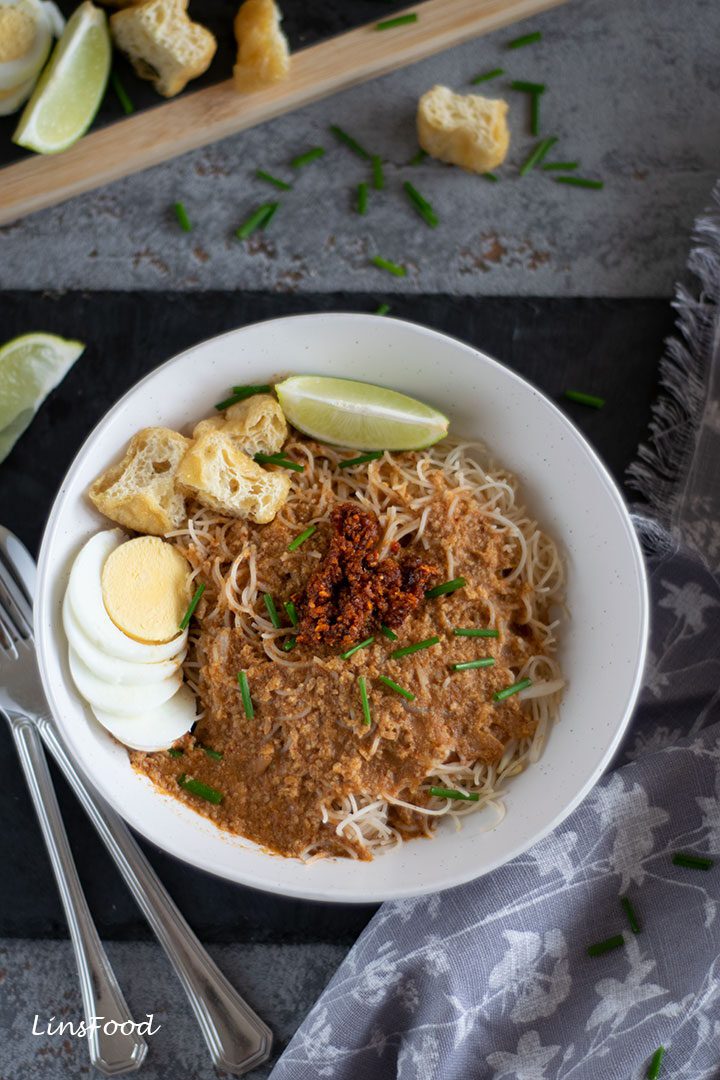
What is Mee Siam Kuah?
It is a hawker centre dish of lightly fried noodles in a gravy that’s a touch sour and a touch sweet, with a whole host of toppings.
If, like me, you don’t have a coffee shop or hawker centre near you, selling all forms of comfort food from the old home, you just have to make it yourself! And so I make these noodles a handful of times a year, as my whole family loves Singaporean and Malaysian food.
Food Memories
Mee Siam Kuah brings back many fond memories of going to the market on Saturday and Sunday mornings with my grandmother.
Wet markets were a way of life in Singapore when I was younger, much as they are, in many parts of Asia. You could get everything there: from fresh vegetables to fresh fruits, fresh flowers, fresh meat and seafood, fresh noodles, fresh tofu; goodness me, everything you needed you would find at the old wet markets. Even fish for our fish tank! And live wriggly worms to feed them!
Our local wet market, which was a two storey complex and a 5-minute walk away, had the fresh ingredients mentioned above, on the first floor. On the ground floor, was where all the hawker stalls were situated, selling all sorts of cooked dishes that make Singapore food what it is – Malay, Chinese, Indian, Nyonya and Eurasian.
Hawker Centre Breakfast
Hawker centres are a collection of food stalls selling all forms of local food and drinks.
For breakfast, the above mentioned market is where I used to go to for my fix of Mee Siam Kuah, Nasi Lemak, Dosa, Putu Mayam (idiyappam), Tahu Panas (Chinese fresh hot bean curd in sugar syrup), oh, the list was endless!
The ground floor was also where we would go to get freshly ground chilli pastes and curry pastes from the ancient looking Indian lady I’ve mentioned in a few other posts.
What’s in a Name?
Let’s take a look at what it means, shall we?
Firstly, it’s pronounced Mee Si-Yum. The last 2 syllables are pronounced quickly as they form a single word.
In the Malay language:
- mee = noodles
- siam = Thailand (the old name, before it was changed in 1939)
- kuah = gravy
So Mee Siam Kuah = Thai Noodles in Gravy.
However, the origin of Mee Siam Kuah is a bone of contention for many; is it Thai, is it Malay, or is it Nyonya? I’ve always viewed it as a Malay dish, as all the stalls selling them when I was growing up in Singapore, were run by the Malays.
You know what though, this grey line is very characteristic of a lot of food in Singapore and Malaysia – so many dishes are claimed by some or all the ethnic communities. This, in my opinion, is but one of the many endearing traits of a multi faceted cuisine!
You can read more about the ethnic mix in Singapore and Malaysia here: Singaporean and Malaysian Recipes.

Types of Mee Siam
There are essentially 2 types of Mee Siam. One is a dry, spiced fried noodle dish which is also commonly known as fried bee hoon; this is the version found all over Malaysia too. And also the region, like the Filipino pancit bihon.
The other, served with a sour and ever so slightly sweet gravy, is the version found in Singapore. My sisters, who have been living in Malaysia since the 80s, tell me that Malaysians often call the gravy version Mee Siam Singapore.
And that is the recipe I’m doing here – Singapore Mee Siam Kuah.
But wait, I’m not done yet! There are 2 types of mee siam with gravy, or mee siam kuah!
Mee Siam Mamak
One is with coconut milk that we call Mee Siam Mamak. The word mamak is a colloquial term for the Tamil Muslim stall owners, derived from the Tamil term for uncle, “mama”. In Asian cultures, as kids, we are encouraged to refer to adults as auntie or uncle, whether we know them or not, as a sign of respect.
So Mee Siam Mamak, with coconut milk, is sold by the Indian Muslim stall owners in the hawker centres in Singapore. Another example of a mamak dish is this Mee Goreng Mamak, Indian Fried Noodles (recipe soon).
Mee Siam Kuah
The second type of Mee Siam Kuah has no coconut milk, and is thickened with a small amount of ground peanuts. This version is synonymous with the Malays and the Nyonyas in Singapore.
Now, did I mention that this is a breakfast dish? Well, it is! It can, however, be found anytime of the day at hawker centres but is still regarded as a breakfast dish, much like Nasi Lemak.
I remember many a morning, going to the wet market with my granny and when all the shopping was done, we’d pop down to the hawker centre for a bowl of mee siam and in my case, tahu panas (hot tofu).
How to Cook Singapore Mee Siam Kuah at Home
There are 3 parts to the recipe:
- The Noodles
- The Gravy
- The Toppings
This is what we’ll be doing:
- First we make the gravy. This is probably the part that requires the most work. We want to make it early and give it at least 2 hours to rest.
You could also make it the day before and leave in the fridge overnight. - Next, we fry the noodles, which is a very quick process. It’s like making fried bee hoon, just not as full on in flavour.
- And finally we have the toppings and condiments. Toppings and condiments are an integral part of any noodle dish, whatever its cultural inclination. More of this below, just before the recipe.
Ingredients

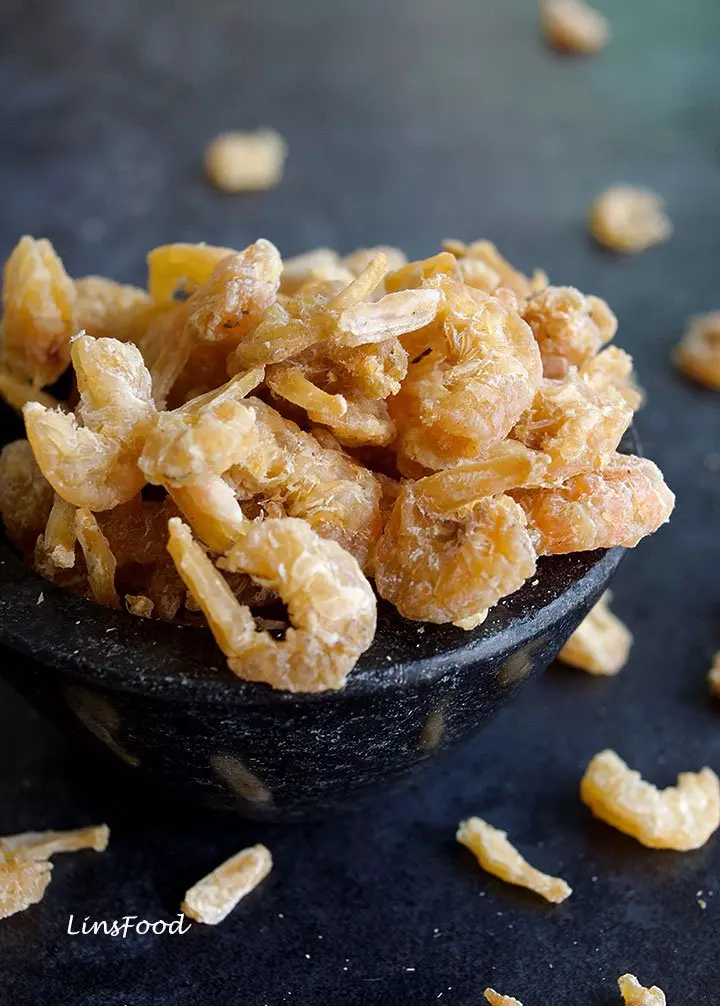
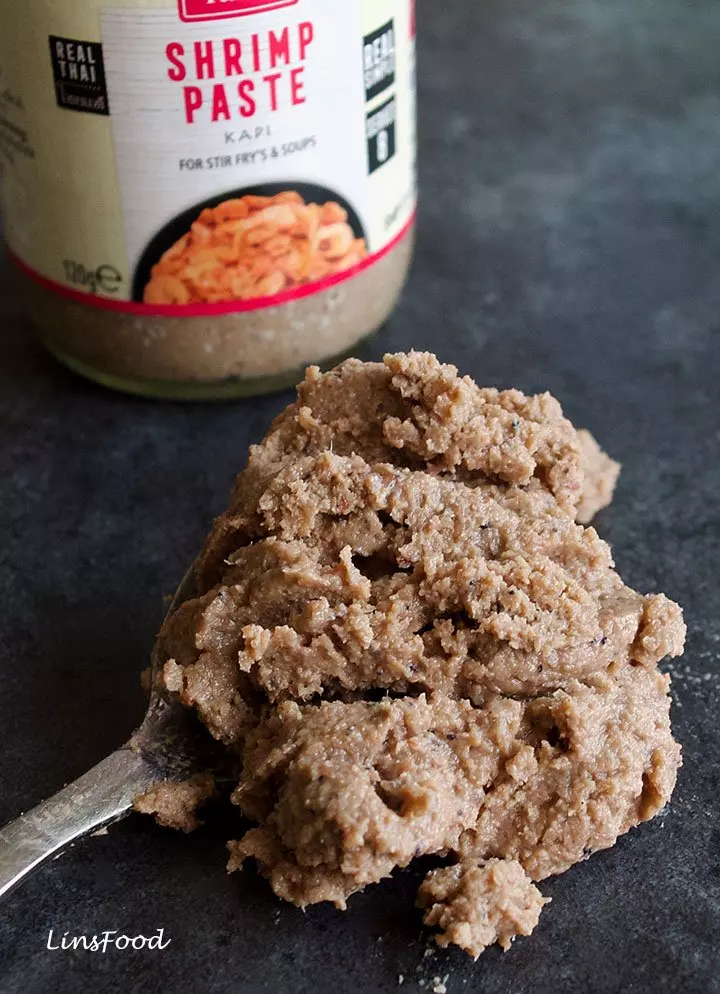
There are a few specialist ingredients here that you will need, to successfully make this Mee Siam Kuah recipe. But if you are Singaporean or Malaysian, you should be used to it! If you don’t have an Oriental store near you, go online. You can get almost anything online, Amazon is really great these days for ingredients.
The Noodles
The noodles in mee siam kuah are rice vermicelli, making this a great gluten free noodle recipe. Just be sure that all other ingredients are also gluten free.
You can find the dried rice vermicelli sold in East and South East Asian stores as well as supermarkets, depending on where you live.
Here in the UK, most of our supermarkets sell fresh rice vermicelli in packets, next to the stir fry vegetables.
If you are using dried noodles, I have a video here on YouTube explaining how to prepare dried noodles. It’s a clip off my Noodles Cooking Class on Udemy.
Taucheo (Fermented Soy Beans)
Click here to read more. This is salted, fermented soy beans and can be found in Oriental shops. If however, you can’t get hold of it, I’ve suggested substituting it with hoisin sauce or red miso paste, something readily available these days. Be sure to get the one with as few added ingredients as possible.
Udang Kering (Dried Shrimp)
Click here to read more. Air dried shrimp, these smell and taste of the sea and are brimming with umami. Leave them out if you can’t get them or substitute with a handful of shiitake mushrooms for an umami hit. Not the same, but, beggars can’t be choosers.
Belacan (Shrimp Paste)
Click here to read more. This is potent and smelly and screams umami. Leave out if you can’t get it. Your gravy won’t be as deep in flavour, but it will still be delicious.
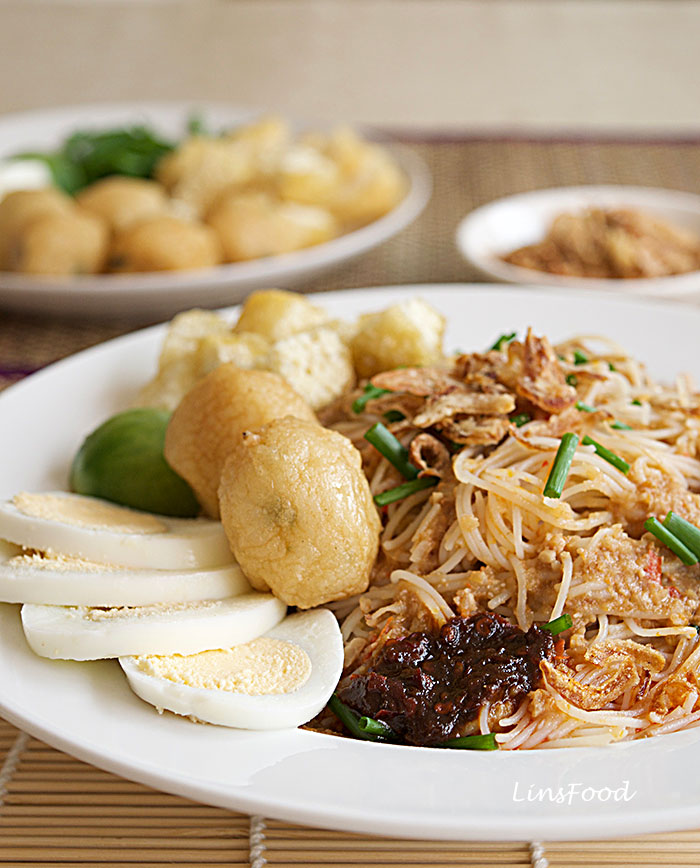
Toppings and Garnish
All noodle dishes are served with toppings and garnishes. For our Mee Siam Kuah, here are your standard toppings. The recipe links for the chilli paste, chilli oil and fishballs are on LinsFood.
- there’s always sambal – this will be homemade chilli paste or chilli sauce like this chilli paste recipe or this sambal bawang. You can, however, get shop bought pastes like sambal oelek or even Chinese Chilli Oil.
- slices of lime (lime juice makes all noodle dishes better!)
- boiled eggs, sliced (1 per person)
- cut up chives
- fried tofu pieces
- fishballs – the Chinese variety (from, you guessed it, a Chinese grocer) but there’s no reason why you can’t use the more common Thai ones
- crispy fried shallots – homemade recipe here but shop bought will suffice
Mee Siam Kuah is a great DIY Party Dish
In Singapore, it is not uncommon to serve this Mee Siam Kuah or Laksa as a party dish. Basically, you place everything on the table: the fried noodles, the gravy and the toppings. Then you let everyone fill their own bowls.
Now, shall we get cooking?
If you enjoy the recipe, drop me a comment and let me know. And if you are feeling like a star, don’t forget that 5-star rating!
If you make this recipe, post it on Instagram and tag me @azlinbloor and hashtag it #linsfood.
Lin xx
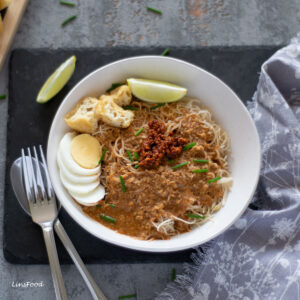
Mee Siam Kuah Singapore (Rice Vermicelli in Gravy)
Ingredients
The Gravy
- 1 large onion quartered
- 2 cloves garlic
- 5 dried red chillies cut up (or 3 fresh ones)
- 2 Tbsp dried shrimp
- 1 tsp shrimp paste belacan
- 4 Tbsp fermented soy beans taucheo (or 2 Tbsp hoisin sauce or red miso paste)
- 3 Tbsp roasted non salted peanuts
- 2 Tbsp vegetable oil
- 3 Tbsp tamarind pulp soaked in 3 Tbsp hot water
- 750 ml water
- ½ tsp sugar
- ¼ tsp salt
For The Noodles
- 600 g fresh rice vermicelli (or enough dry, for 4 people)
- 2 handfuls beansprouts
- 1 Tbsp vegetable cooking oil
- about 10 chives chopped
- ½ tsp salt
To be Ground to a Paste
- 1 medium onion
- 1 clove garlic
- 1 fresh red chilli
- 2 Tbsp dried shrimp
Garnish
- sambal
- 1 lime cut into wedges
- 6 boiled eggs halved
- small handful chives chopped
- 8 fishballs or 2 fishcakes, sliced
- 4 handfuls fried tofu
- 4 Tbsp crispy fried shallots
Instructions
The Gravy
- First of all, soak the dried chillies and the dried shrimp in very hot water (just off the boil) in 2 separate bowls, while you get all the other ingredients ready.
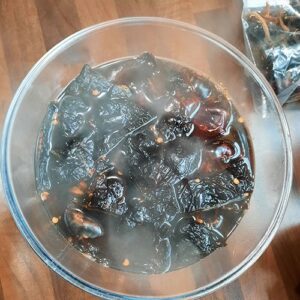
- Dry toast the peanuts if not ready toasted. Set aside to cool.
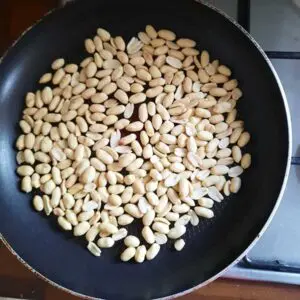
- Place the onions, garlic, chillies, dried shrimp, shrimp paste, taucheo and peanuts in a chopper and chop until fine.

- Heat the oil in a large saucepan and sauté the chopped ingredients for about 3 minutes on medium heat until you get a lovely aroma coming off it.

- Add the tamarind, sugar and the water, stir and bring to boil.

- Lower the heat, and simmer, uncovered, for 20 minutes, taste the seasoning. Add some salt if you think it needs it. Turn the heat off and let it sit for a couple of hours at least.
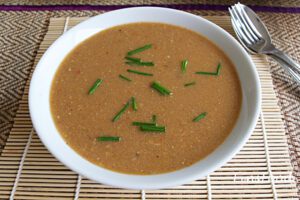
The Noodles
- Place all the ingredients to be ground in a chopper and grind to a fine paste.
- Heat the oil in a large wok and sauté the ground spices for a couple of minutes on medium heat until you get a lovely aroma off it.
- Add the noodles, bean sprouts and salt and mix it all up and fry until the noodles are done, about 2 minutes.
- Check the seasoning. It should be tasty but just on this side of full on flavour as that will come with the gravy.
- Add the chives and mix.
To serve
- Heat the gravy up.
- Place the noodles in a bowl.
- Ladle some gravy over.
- Top with all or the toppings of your choice, whether it's the egg, the sambal, the tofu, etc. All noodle dishes are made better with a squeeze of lime juice!
Notes
Total time does not take into account the resting time for the gravy, before serving.

These noodles were amazing, just like I remember them. Thank you for a very detailed recipe once again!
My pleasure, Adam. I’m so pleased that you enjoyed them!